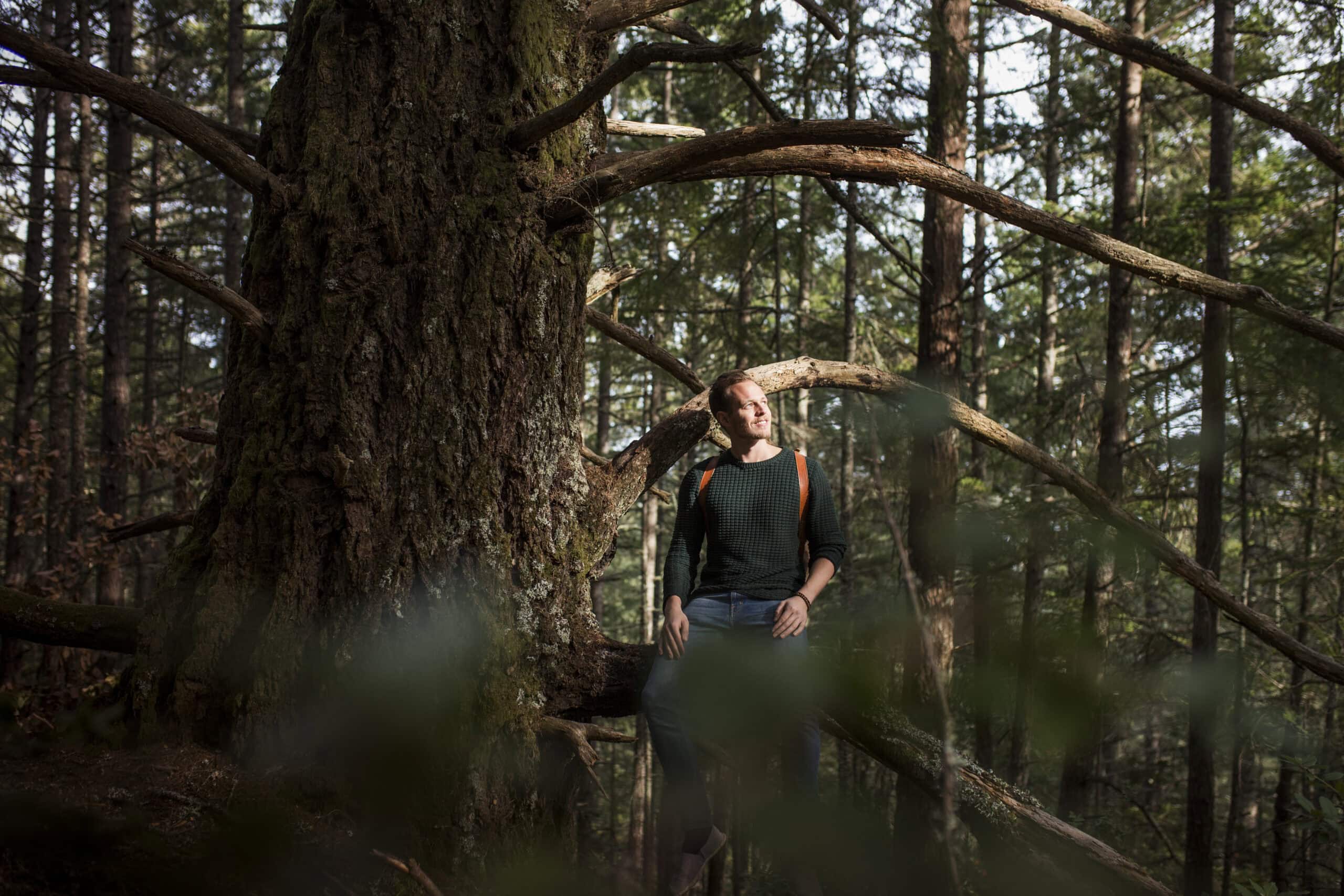We’ve all felt it—that tingling, breath-stealing sensation in the presence of something far greater than ourselves.
A starlit sky. A cathedral’s hush. The cry of a newborn.
These “mystic moments” leave us speechless—but they also change us. Science now shows that awe – a powerful, sometimes transcendent emotion – can quiet self-talk, sharpen attention, and nudge our choices toward connection and care.
What makes awe so transformative? It turns out, awe challenges the very structure of how we see the world—and ourselves within it. It gently interrupts the “I” and widens the “we.”
This “pause and shift” also mirrors how wonder shapes bodily awareness. In our article Wonder Starts in the Body: How Awe Moves Us—Literally, we explore how awe activates both the nervous system and our social brains.
Neuroscience Insight
When we feel awe, brain activity in the default mode network (DMN) – the system tied to rumination and self-focus—drops, while attention and sensory systems switch on (1). Think: less inner chatter, more present-moment noticing.
In cognitive–behavioural terms, awe functions as a context updater. It makes mental frames a bit looser, which supports reframing and flexible thinking (4). That’s why awe-centred approaches—nature time, contemplative practice, carefully guided experiences—are being tested across therapies (4, 6).
This mirrors what we shared in The Neuroscience of Words, where shifting attention from internal chatter to external input changes how language rewires the brain.
We have solid short-term findings (e.g., reduced DMN activity, shifts in appraisal), but long-term structural brain changes in humans remains uncertain. Most studies are brief or cross-sectional; we still need multi-wave MRI/DTI studies that link neural change to behaviour over months or years (see 1, 4, 6).
People don’t respond to awe in the same way. Individual traits (e.g., openness, absorption), a sense of threat vs. safety, culture, and the setting (nature, art, ritual, VR, psychedelics) all shape whether awe broadens perspective and calm—or flips into “threat-based” awe marked by anxiety and powerlessness. (8).

What Awe Really Does to the Brain
Awe is a recalibration of the self. Neurologically, with the default mode network (DMN) quieter, it’s easier to see ourselves as part of the larger system rather than the centre of it (1).
At the same time, awe activates attention and sensory networks, pulling us into the present moment. In other words, awe both silences the ego and awakens awareness—a rare neurological cocktail that may explain why it feels so deep, and why it sticks with us.
It can also expand our sense of time—people report more time availability and patience after awe—creating cognitive space for wiser choices rather than knee-jerk reactions.
The “Small Self” and the Big Shift
A consistent finding across awe research is that it triggers what’s called the “small self”—a feeling of being smaller, not in a diminished sense, but as part of something greater (2). This shrinking of the self is powerful. It reduces defensiveness, softens biases, and makes us more open to new ideas and people.
In fact, awe can reduce implicit prejudice and increase identification with all humanity. It’s one of the few emotions that naturally expands empathy beyond our immediate group.
Importantly, the small-self effect shows both universal and cultural variation: across cultures, awe tends to reduce self-focus and increase collective engagement, yet which cues evoke awe and how it is interpreted differ by cultural meaning systems. Designing awe experiences with cultural sensitivity strengthens their positive impact.
This aligns closely with our insights from Bilingualism and Empathy in Childhood, where language fluency links with wider perspective-taking and care across differences.
PAUSE AND REFLECT
Right now, what three details (one far, one mid, one tiny) can you perceive that weren’t in your awareness 10 seconds ago?
Why Mystic Moments Shift Behaviour
Mystical or awe-inducing experiences lead to different choices. In experiments, people exposed to awe (through nature, childbirth, or ritual) were more likely to act in line with their spiritual values, feel connected to others, and express deeper moral intentions (3).
These changes are behavioural:
- More generosity and altruism
- More environmental concern
- Greater tolerance of uncertainty
- Increased mindfulness and reflection
Awe can also broaden moral concern—beyond one’s in-group to distant others, animals, and ecosystems—via a shift in self-concept toward connectedness (“small self”). This moral expansiveness helps explain downstream pro-sociality and care for the natural world.
Educational and community settings are ideal for cultivating these effects: micro-awe practices in classrooms (e.g., “one-minute wonder,” close observation, field or museum visits), community stargazing or species-spotlight walks, and immersive media can boost empathy and pro-environmental intention when paired with reflection and local action (9).
People exposed to awe were more likely to act in line with their values, express moral intention, and broaden their concern beyond their immediate circle. That sense of expanded belonging is similar in spirit to what we explore in our blog piece, where mapping invisible relational ties can reshape team culture and collective care.

Awe in Therapy and Healing
Clinically, awe is attracting interest beyond psychedelics—through nature immersion, contemplative practice, and guided experiences—because it appears to increase cognitive flexibility and support reframing entrenched narratives (4). Psychedelic-assisted approaches often aim to facilitate awe-laden/mystical experiences; patients frequently report shifts in meaning, identity, and purpose, sometimes after a single session (6).
Current evidence supports flexibility and reappraisal mechanisms; direct, long-term structural plasticity data in humans is still emerging (4, 6).
How to use awe responsibly:
- Position awe as a catalyst, not a cure. Pair it with skills training (reframing, values-based action, emotion regulation) and check maintenance at 1–3–6 months.
- Practical tools: micro “awe walks,” guided aesthetic attention, values-anchored rituals, VR nature, meaning-making exercises.
- Safety first: screen for trauma; some clients may tilt toward threat-based awe.
- Integration matters: awe should augment, not replace, core therapy (exposure, behavioural activation, regulation).
Until stronger longitudinal evidence accumulates, we can position awe as a catalyst that can support change—not a standalone driver of lasting brain re-wiring.
There’s a parallel in Dancing with Archetypes, where symbolic narratives and movement help children access their inner worlds. Both approaches invite meaning-making through sensorimotor or emotional experience, not just intellectual reflection.
Practical implications
Practically, clinicians can integrate awe-centred methods—brief “awe walks,” guided aesthetic attention, values-anchored ritual, VR nature, or meaning-making exercises—to increase cognitive flexibility and reappraisal while monitoring client safety (e.g., trauma histories that may bias toward threat-based awe).
Awe should augment—not replace—core therapeutic skills (emotion regulation, exposure, behavioural activation), and work best within holistic, person-centred formulations.

Limits Matter
Awe is not a panacea—effects are context-dependent, often short-lived without scaffolding, and can be counterproductive when elicited via threat (e.g., disasters, coercive rallies), which tends to reduce wellbeing and agency.
Link awe to skills practice, social support, and environmental affordances to translate state shifts into durable behaviour change (8).
Risks & downsides
Threat-based awe (e.g., evoked by disasters, intimidation, or coercive mass events) can elevate anxiety, reduce perceived agency, narrow conformity, and in some contexts increase out-group derogation.
Screen for trauma histories; emphasise safety, autonomy, consent, and meaning-focused elicitors (nature, art, prosocial ritual) rather than fear-laden ones. Build in debriefs and grounding practices to mitigate overwhelm (4, 6, 8).
You Don’t Need a Psychedelic to Feel It
Perhaps most encouragingly, awe is available to everyone. You don’t need to hike Machu Picchu or take ayahuasca to feel transformed. In a large-scale study, people who regularly experienced awe and gratitude—especially through nature, art, and meaningful connections—showed higher wellbeing and more spiritual engagement, regardless of religious belief (7).
These moments may seem fleeting—but their ripple effects are anything but.
Try regular, low-friction awe habits: a daily “awe walk,” two minutes of aesthetic attention to natural patterns, slow-looking at art or craft, listening to choral or orchestral soundscapes, or micro-rituals of appreciation with loved ones. Frequency beats intensity; small, repeated doses accumulate.

Cultural Connection
Awe is a shared cultural technology. Communities don’t just feel awe; they make it—through light, sound, rhythm, and coordinated attention that softens the “me” and widens the “we.”
Practices as varied as lantern festivals and candlelight vigils, call-and-response choirs and stadium anthems, Hanami blossom-viewing and Diwali diyas, Ramadan iftars and graduation rites channel a common pattern: synchronise – witness something larger – name what matters now. These moments reliably evoke the “small self,” heighten social connectedness, and prime helping intentions (2, 3, 7).
Protest chants, haka and welcome ceremonies, football terrace singing, neighbourhood sky-watch nights, and naming/birth ceremonies all create brief expansions of identity that carry moral momentum—we belong together, so we act together.
In Collecting Memories for Your Children, we also highlight how cultural storytelling anchors belonging across generations. Both memory and ritual help weave wonder into life and community.
Encouraging cultural practices that evoke awe—from interfaith music events to seasonal nature ceremonies and civic rites of gratitude—can strengthen social cohesion and cooperation. To avoid backfire, emphasise safety, inclusion, and meaning, steering away from threat-based elicitors.
Designing civic or cultural awe responsibly means avoiding fear-inducing spectacle and privileging inclusive, participatory forms (shared music, lantern walks, stargazing nights) that expand care without manipulating crowds. Where awe is intense, provide opt-outs, quiet zones, and post-event reflection prompts to consolidate pro-social meaning while reducing stress carryover.
Free Resources for Parents
Parenting is a journey of mutual growth—and we’re here to support you along the way.
Explore our collection of free resources, including story dice, printable guides, conversation starters, and more—designed to help you deepen connection, build emotional resilience, and embrace mindful parenting.
Sign up for our newsletter and get access to our Freebies Library to explore tools that support your parenting journey.

So Why Does Awe Change Us?
Because awe interrupts the self. It expands our perception of time, shifts our priorities, and breaks the illusion that we are the centre of the universe. In a world full of distraction and division, awe reminds us we are part of something interconnected—and that insight, it turns out, has the power to reorganise the mind.
Mystic moments aren’t rare because they’re inaccessible. They’re rare because we don’t slow down to notice them. But when we do, the science is clear: awe has the potential to make us not only feel better—but be better.
And when we pair awe with regular practice, supportive relationships, and enabling environments—homes, schools, clinics, and communities that make wonder easy—its effects travel further and last longer.

Reflect
Write a single word on a sticky note—sky, pattern, or kindness.
Each time it catches your eye, pause and name one fresh “wow.”
References:
- Van Elk, M., Gomez, M. a. A., Van Der Zwaag, W., Van Schie, H. T., & Sauter, D. (2019). The neural correlates of the awe experience: Reduced default mode network activity during feelings of awe. Human Brain Mapping, 40(12), 3561–3574. https://doi.org/10.1002/hbm.24616
- Stell, A. (2018) Awe as a self-transcending emotion. University of Sussex. https://sussex.figshare.com/articles/thesis/Awe_as_a_self-transcending_emotion/23456144?file=41164856.
- Cappellen, P.V. and Saroglou, V. (2012) Awe activates religious and spiritual feelings and behavioral intentions. Psychology of Religion and Spirituality, 4(3), 223–236. https://doi.org/10.1037/a0025986
- Schaffer, V., Huckstepp, T. and Kannis-Dymand, L. (2023). Awe: A Systematic Review within a Cognitive Behavioural Framework and Proposed Cognitive Behavioural Model of Awe. International Journal of Applied Positive Psychology, 9(1), pp. 101–136. https://doi.org/10.1007/s41042-023-00116-3.
- Leonard, D., & Brooks, T. R. (2025). Peak Experiences Matter. Journal of Humanistic Psychology, 0(0). https://doi.org/10.1177/00221678251330066
- Hendricks, P.S. (2018). Awe: a putative mechanism underlying the effects of classic psychedelic-assisted psychotherapy. International Review of Psychiatry, 30(4), pp. 331–342. https://doi.org/10.1080/09540261.2018.1474185.
- Büssing, A. (2021). Wondering awe as a perceptive aspect of spirituality and its relation to indicators of wellbeing: frequency of perception and underlying triggers. Frontiers in Psychology, 12. https://doi.org/10.3389/fpsyg.2021.738770
- Gordon, A. M., Stellar, J. E., Anderson, C. L., McNeil, G. D., Loew, D., Keltner, D. (2016). The dark side of the sublime: distinguishing a Threat-Based variant of awe. Journal of Personality and Social Psychology. https://sites.lsa.umich.edu/whirl/wp-content/uploads/sites/792/2020/08/2017-The-dark-side-of-the-sublime.pdf
- Zhao, H., Zhang, H., Xu, Y., Lu, J., & He, W. (2018). Relation between awe and environmentalism: the role of social dominance orientation. Frontiers in Psychology, 9. https://doi.org/10.3389/fpsyg.2018.02367
This piece was written for you by
Making complex ideas accessible and sparking meaningful conversations.
